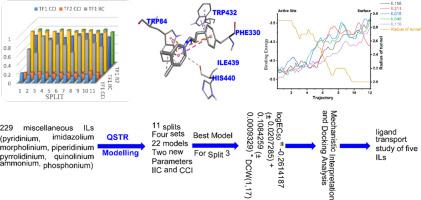Journal of Molecular Liquids ( IF 5.3 ) Pub Date : 2020-08-14 , DOI: 10.1016/j.molliq.2020.114055 Ashwani Kumar , Parvin Kumar

|
Ionic liquids (ILs) have enticed the curiosity of chemists due to their vast applications in academic and industrial research. These have many advantages over other conventional solvents such as broad liquid temperature, negligible vapour pressure, non-volatility, etc. But, from an environmental point of view, these advantages can develop heterogeneous toxic results when released into the environment. It is important to predict the toxicity of ionic liquids. A useful tool for predicting ILs toxicity is the quantitative structure-toxicity relationship (QSTR). The toxicity of ionic liquids is evaluated by predicting the acetylcholinesterase (AChE, EC3.1.1.7) enzyme inhibition. In the present manuscript, an exhaustive QSTR analysis for 229 ionic liquids as an acetylcholinesterase enzyme inhibitor is described using the inbuilt Monte Carlo optimization method of CORAL software. Eleven splits are prepared and from these split, 22 QSTR models are developed using two target functions, i.e. TF1 (without IIC) and TF2 (with IIC). All models developed by TF2 are robust and have better predictability. The model developed for split 1 using TF2 is considered as the best model (RValid2 = 0.7782). In the present work, a novel parameter “Correlation Contradiction Index (CCI)” is studied to recognize its predictability. The docking simulation was also performed to understand the mechanistic interpretation. Further, the mechanistic interpretation of the best QSTR model was in good correlation with the three-dimensional studies of ligand binding. In order to see the true picture of inhibitory potential, ligand transport study of five ILs (IL015, IL040, IL116, IL156 and IL211) was studied in the tunnel leading to the active site of AChE using the services of Caver Web. Result of the transport study showed that these ILs formed a most stable complex in the active site and not in the tunnel and did not obstruct the tunnel for the accessibility of the enzyme active site for the substrate.
中文翻译:

使用具有理想相关性指数和相关矛盾指数的新型QSTR模型对离子液体对乙酰胆碱酯酶的定量结构毒性分析
离子液体(ILs)由于其在学术和工业研究中的广泛应用而吸引了化学家的好奇心。与其他常规溶剂相比,它们具有许多优势,例如宽的液体温度,可忽略的蒸气压,不挥发等。但是,从环境角度来看,这些优势在释放到环境中时会产生多种毒性结果。预测离子液体的毒性很重要。预测ILs毒性的有用工具是定量结构-毒性关系(QSTR)。通过预测乙酰胆碱酯酶(AChE,EC3.1.1.7)酶的抑制作用来评估离子液体的毒性。在本手稿中,使用内置的CORAL软件的蒙特卡洛优化方法,对229种离子液体作为乙酰胆碱酯酶抑制剂的详尽QSTR分析进行了描述。准备了11个分割,并从这些分割中使用两个目标函数(即TF)开发了22个QSTR模型1(不带IIC)和TF 2(带IIC)。TF 2开发的所有模型都很健壮,并且具有更好的可预测性。使用TF 2为拆分1开发的模型被认为是最佳模型(R有效2= 0.7782)。在目前的工作中,研究了一种新颖的参数“相关矛盾指数(CCI)”以识别其可预测性。还进行了对接仿真以了解机械解释。此外,最佳QSTR模型的机理解释与配体结合的三维研究高度相关。为了了解抑制潜力的真实情况,使用Caver Web服务在通向AChE活性位点的通道中研究了五个IL(IL015,IL040,IL116,IL156和IL211)的配体转运研究。转运研究的结果表明,这些IL在活性位点而不是在通道中形成最稳定的复合物,并且不会阻碍酶活性位点对底物的可及性。


















































 京公网安备 11010802027423号
京公网安备 11010802027423号